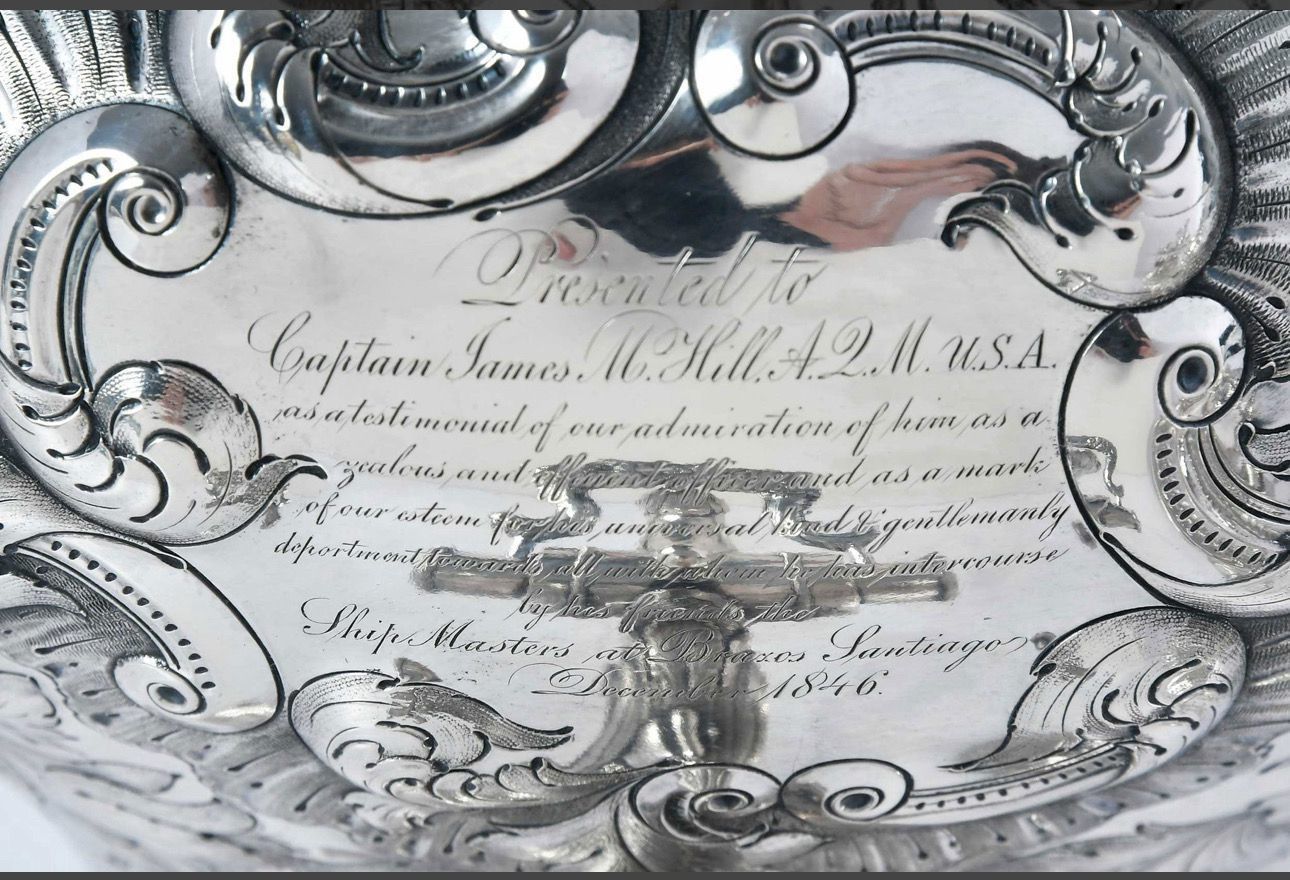James Hill [Tea Service: Urn]
Name/Title
James Hill [Tea Service: Urn]Description
Coin silver tea urn inscribed "Presented to / Captain James M. Hill A.Q.M. U.S.A / as a testimonial of our admiration of him as a / zealous and efficient officer and as a mark / of our esteem for his universal kind & gentlemanly / deportment towards all whom he has intercourse / by his friends the / Ships Masters at Brazos Santiago / December 1846". This urn is engraved with scrolls and floral decorations, has ivory spacers, and is marked for Horace E. Baldwin & Co. (New Orleans, Louisiana, working 1842-1853). Grouped with similar a three piece tea service consisting of a tea pot, sugar bowl, and milk jug (creamer), all engraved with an "H" monogram.Context
In the mid-1830s, the Mexican government established a coastal battery at the northern end of Brazos Island overlooking the pass. The gun emplacement was a simple affair. It was comprised of a raised wooden platform upon which several cannon were mounted and a magazine of palmetto logs packed with clay and covered by several feet of sand. Much of the island was inundated in the hurricane of 1844 and the governor of Tamaulipas ordered the citizens to relocate to the nearby village of Fronton, or Port Isabel as we call it today. Soon after his arrival in early March 1846, Zachary Taylor had Captain James Hill, Assistant Quartermaster, establish a supply depot at Brazos Island, now called Boca Chica Beach. Because of the dangerous sandbars located along the Texas coast, large ships would lie at anchor about a mile offshore. Cargo was off-loaded onto shallow-draft boats, called lighters, and then carried into the wharves located at Brazos Depot. From there it was sent inland by cart or up the Rio Grande by steamboat. Major Thomas Eastland, a quartermaster for the United States Army, wrote the following concerning his tour of duty at Brazos Depot during the Mexican-American War of 1846: “This depot was the great channel through which passed the troops and supplies for the Army operating on the upper line and from which was embarked the returning Army, munitions of war, etc. The accumulation of property at the depot was immense and its protection a matter of serious and anxious consideration. My predecessor Captain J.M. Still, had commenced erecting suitable warehouses and I considered it my duty to continue until all the stores subject to injury by exposure, were safely sheltered.” Houses, barracks and workshops were also built to shelter the men, as was a long line of piers and docks. “It became necessary to construct wharves,” Eastland’s report continued. “This was done in a very cheap manner, by using old vessels, no longer fit for service.” In other words, decrepit old sailing ships, no longer fit for sea were purposely scuttled with their hulks being converted to docks and wharves. In May of 1850, Major Chapman declared his only wharf boat had, “gone to pieces during the recent severe northers.” He proposed to, “Scuttle the hulk of the Colonel Stevens as a new wharf or pier head….the position in which I place her to greatly protect the depot from action of the water during northers.” Captain James Hill was the assistant quartermaster, succeeded in establishing the depot, receiving Zachary Taylor's force of 2,300 men and 400 wagons, and supplying the Army of Occupation to victories during the Texas Campaign [the first front in the Mexican–American War with the Battle of Palo Alto (May 8), the Battle of Resaca de la Palma (May 9)] against a numerically superior Mexican army. Captain Hill continued to supply , and the Battle of Monterrey (September 20–24). This tea service was presented to Captain Hill by the Ship's Masters at Brazos Santiago on December 1846.Category
Texas Silver
Early Texas Furniture and Decorative Arts

